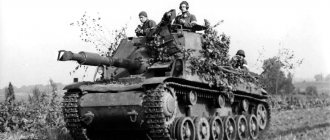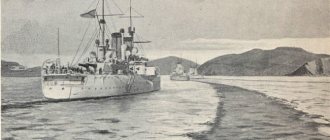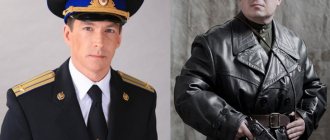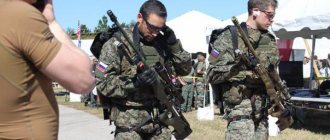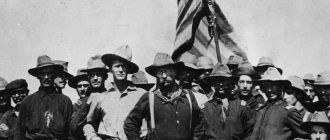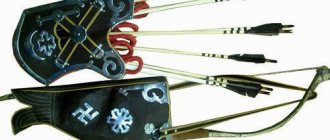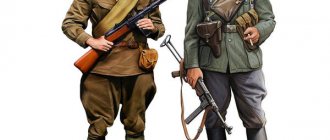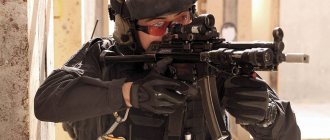Russian infantry of the late 18th century.
Equipment of the French infantry (grenadier and voltigeur), 1808.
Allied soldier combat equipment (World War II)
Development of combat equipment
In the army of the Russian Empire, a supporter of wearing “everything on oneself” was the great Russian commander Alexander Vasilyevich Suvorov. Over the years, the personnel of Suvorov’s regiments were accustomed to wearing multi-pound backpacks, which at that time were called “winds” (for the ease with which Suvorov’s soldiers carried them). Due to the fact that A.V. Suvorov himself never forced his subordinates to carry more than he could carry himself, he very competently selected the permissible payload for his soldiers, which made this experience unique in its own way for that time.
However, until the Anglo-Boer Wars of the late 19th century, most of the equipment of military personnel was transported in the wagon train, and in its entirety it was almost impossible to wear constantly. With the development of military science, in modern armed forces (especially in troops of constant combat readiness and units on combat duty), more and more items of equipment are constantly worn by servicemen, are compact and relatively light for constant wear.
The value, quantity and cost of equipment is growing quite quickly. According to Brigadier General Mark Brown (responsible for developing equipment for the US ), in the 1940s, Americans went to war in uniform, with a rifle, helmet, roll and canteen. Their equipment weighed about 16 kg and cost - taking into account inflation - 170 dollars. In Vietnam, the equipment of a soldier already cost 1.1 thousand dollars: in particular, body armor , weapons were updated. Now Americans fighting in Iraq and Afghanistan are required to be equipped with body armor and helmets made of composite materials, safety glasses, fire-resistant uniforms, including gloves and boots , night vision devices, and laser designators. Their equipment includes over 80 items with a total weight of about 34 kg. Combat equipment for a modern soldier costs the Pentagon approximately $17,500—100 times more than during World War II. According to the general’s estimates, by the middle of the next decade, the equipment of an infantryman will already cost from 28 to 60 thousand dollars. In particular, soldiers will receive small arms that allow them to conduct targeted fire at the enemy from around the corner without leaning out, and computers with screens so that everyone can see the picture of the battle.
Orientation by the stars
Home – Orientation – Orientation by the stars
Navigation during extreme wilderness survival is extremely important. You need to use all possible methods and signs to navigate unfamiliar terrain and choose the right path to salvation.
In many extreme areas, traveling at night is extremely dangerous. This has to be resorted to only when walking during the day is impossible due to heat or other reasons. But a clear, starry night is a great time to navigate by the stars and plan a route for the next day. Of course, orientation at night is very limited, since the sky is not always clear and the stars are clearly visible, but during the day they simply are not there. But when there is an opportunity, you need to use the stars.
Of course, the main night landmark in the northern hemisphere is the North Star , pointing north. In a clear starry sky it is not difficult to find the constellations: Ursa Major and Ursa Minor . Of course, our ancestors had a very rich imagination. These constellations do not resemble bears at all. These are more like two “buckets”. The extreme star in the handle of the Ursa Minor bucket is the Polar Star . If the Ursa Minor itself is poorly visible, but the big one is better (this often happens), we take the distance formed by the two outermost stars of the Ursa Major bucket and put it along the same straight line five times - that’s where the Polar Star will be.
Why are we so obsessed with finding the North Star? The reason is simple: the celestial sphere is not static, constellations and stars are constantly moving and at different times of the year it is extremely difficult to navigate by them. Only the North Star is practically motionless , always located in the polar sector of the sky and points strictly north . It is precisely this feature that makes it valuable for those who want to navigate unfamiliar terrain.
So, we found the North Star and now we know where north is. How to determine the other cardinal directions? Well, it's actually simple. We stand facing north - the south will be behind us, the east will be on our right hand, and the west will be on our left (Photo).
In the southern hemisphere, the main landmark is the Southern Cross constellation (Photo). You should be careful, since in the sky of the Southern Hemisphere there is also the so-called. False cross, but the real Southern Cross is much brighter than the False Cross and its stars are closer to each other, more compact. Orientation using the Southern Cross is more confusing than using the North Star. To determine the direction to the south (South Celestial Pole), use the star pointers to the left of the cross. A speculative line B-C is drawn between them and a perpendicular is built. The intersection of this perpendicular with the axis of the Southern Cross will give the direction to the south.
You can also successfully navigate by the moon when it is clearly visible (especially during the full moon). By and large, the Moon moves in the same way as the luminary of the day - the Sun. And they navigate by it too. We will talk about solar orientation in a separate article.
At night, while in your impromptu camp, you navigate by the stars and choose your directions for the next day. In order not to lose the chosen direction in the morning, it is worth laying out an arrow-pointer made of stones or branches on the ground. And when the time comes to leave the camp and move out, stick to the direction chosen at night. Here's a little secret.
Support the project on social networks:
Compound
It is often difficult to clearly classify equipment into a specific class, since it is integrated into one another or has several functions. But functionally they are divided into several areas and include: Personal protective equipment (both anti-radiation and anti-chemical and armor protection), communications and detection equipment, optical instruments and night vision equipment, shovels and other tools, lighting and signal ammunition and other pyrotechnics , maps, compasses and topographical instruments, flasks and kettles, basic necessities and other things - depending on the military specialty and the actual functions performed - carried by the military personnel in a knapsack, backpack or duffel bag, as well as in unloading and on a waist belt.
Equipment should not be confused with weapons. The latter includes all objects and devices intended to destroy the enemy. Due to the fact that some items of equipment can also destroy a person (for example, a sapper shovel), you should pay attention to the main functional purpose of the item.
Clothing and fire protection equipment
US
National Guardsman , 1917
They carry out the tasks of making a serviceman comfortable in the appropriate conditions of natural zones (from desert to ocean) and protecting him from enemy fire. It may also include elements of radiation, biological and chemical protection, microclimate and cooling systems, and first aid.
The clothing that the military is equipped with is quite diverse: boots and shoes , knee pads and elbow pads a light undershirt and , a medium shirt and trousers : a jacket for cold weather made of sheep wool; jacket against the wind; soft jacket and trousers : rain protection set; jacket and trousers with fur. The 3rd generation of cold climate clothing was developed for use in the far north. It consists of multi-layer insulation, as a result, the clothing allows the soldier to adapt to the cold climate.
Clothing may contain elements or a separate microclimate system, cooling - worn under a protective uniform, or an aqua system for drinking.
Clothing can be made of non-flammable materials, be waterproof and have a camouflage color. Even systems with active (changing depending on environmental conditions) camouflage are being developed. Include sunglasses, windproof glasses and dustproof glasses .
Fire protection equipment usually includes a hard hat (also a helmet ) and body sometimes goggles . Some units have in their arsenal portable protective equipment based on the shield principle. Fire protection means are constantly being improved in parallel with the strengthening of weapons and are sometimes able to protect against very serious mechanical and fire effects.
Recent developments in combat equipment include exoskeleton elements. The exoskeleton structure is an external frame that allows you to remove excess stress from a person’s muscles and increase their muscle strength.
Means of communication
From a simple walkie-talkie, communication means have turned into multi-stage communication systems between different levels of command staff and commanders and soldiers during battle (for example, “company commander - platoon commander - leader - soldier”). Uses advanced computer, communications and Global Positioning technology to unite disparate soldiers into a single digital battlefield. The system components include a helmet-mounted computer sight, a navigation module, a radio communication system and a multifunctional laser, which are combined into a single battle management system. The Soldier has communications with other Soldiers, command posts, support vehicles, and aircraft.
Reconnaissance and navigation equipment
Starting with simple binoculars, reconnaissance tools have been continuously improved.
Night and infrared vision devices, optical and acoustic bugs, means of connecting to electronic communications, this is not a complete list of such means.
Goggles or night vision devices are used independently or mounted on a helmet. With their help, you can detect a person in starlight at a distance of up to 150 and in moonlight up to 350 m.
Devices for orientation, target identification, mine detection, various sensors and signaling devices.
Equipping a warrior with a personal computer built into his suit significantly improves his reconnaissance capabilities. Using an intelligent system, a soldier can see his location, the locations of other soldiers, and known enemy positions on a large-scale map display. In addition, he can see the position of the enemy, just by his hand, determines the type of weapon by its appearance or thermal image.
With a multi-function laser, a soldier can identify enemy positions to be marked on a general map. Can transmit enemy coordinates to call fire. Systems of mini and micro aircraft with a wingspan from 20 cm to 8 mm have been developed. Capable of not only quietly collecting intelligence data, but also containing a decent amount of explosives “on board”. The project already includes “nanorobots” of almost unobservable size.
Life support
US
troops in Iraq (2003)
Various multifunctional items and devices that serve to support actions related to combat.
A raincoat-tent (some can serve as a stretcher or several tents connected to each other allow you to assemble a tent of large volume), a raid backpack, a heat-insulating mat , combat unloading vests (worn over ammunition and body armor with pouches and pockets for carried weapons and ammunition), a sleeping bag, mosquito net, inflatable pillow, etc.
Survivability means make a soldier resistant to the effects of enemy weapons, diseases and an unfavorable environment. They include means of radiation, chemical and biological reconnaissance, protection, disinfection, as well as air conditioning (heating) systems, noise protection, and reduction of optical, thermal and radar signature. For example, a piece of camouflage net (2x2 m), for camouflaging a soldier and property during stops. The color of the network is determined by the type of terrain, vegetation and time of year.
All products meet strict conditions for functionality, reliability, and wear resistance.
Medical support
A basic personal first aid kit includes:
- Pain reliever.
- Antibiotics.
- Tablets for water disinfection.
- Lip cream.
- Antiallergic agent.
- Tablets for indigestion.
specially equipped suit is capable of conducting full medical monitoring of the physiological state and transmitting data to the command center. And even if injured, immediately treat the wound with medications.
Individual protection means
In the event of the use of weapons of mass destruction - personal protective equipment for the respiratory system, eyes, as well as skin, protective gloves and stockings.
Modular equipment
Modular combat tactical and cargo equipment consists of different types of backpacks, as well as a tactical combat vest with interchangeable quick-release pouches (for magazines of individual small arms, hand grenades and other equipment items), and a waist belt. If necessary, you can quickly get rid of the backpack. Also, for parachute landing, the fighter is equipped with a Parachute System.
Special elements
Usually found in an unloading vest. Approximate minimum contents of the vest:
- Compass.
- Mirror for signaling.
- Penknife . _
- Hunting knife .
- Pistol with two magazines.
- A shooting device for firing signal flares.
- Strobe light with infrared filter.
- Whistle.
- Lighter.
- A small flashlight.
- Emergency food ration.
- Survival kit including:
- Spare compass .
- Windproof matches or lighter.
- Condom or 5-liter water bag.
- Pocket knife or skinning knife
- Sewing kit.
- Fishing line and set of hooks.
- Travel bag.
- A flask of water (2 liters).
- First aid kit
- Insect repellent .
- Ammunition used first (magazines, belts, grenades, etc.).
- Wiping, brush and lubricant.
Additionally
Also possible:
- Survival Tools
- Water purification filter
- Night work kit
- Individual heat source
- Camouflage makeup.
They do not belong to combat equipment, but are also constantly with the serviceman:
- Weaponry
: The standard set of a soldier includes individual (and group) small arms and bladed weapons (and accessories), but depending on the specialization of the soldier and tactical tasks, it may include a wide range of weapons including flamethrowers, mortars, grenade launchers, air defense systems, portable missile launchers (ATGM, MANPADS), etc.
- Food supply
: The amount of food depends on the duration of the action and the individual characteristics of the soldier. The amount of food for one day is approximately 1 can of canned meat, 200 grams of rice and 2 bars of chocolate. - Water
: The amount of water depends on the situation, terrain, weather conditions and the availability of natural water sources.
On average, 2 liters of water per day at an average pace of march. The flasks have covers made of dark or camouflage fabric, which act as a heat insulator and reduce noise. The lids of the flasks have rubber seals for tight closure and are tied to the flasks to prevent their loss in case of danger. Empty plastic bags are filled with water and used for storing it when stationed or staying at an observation post for a long time.


